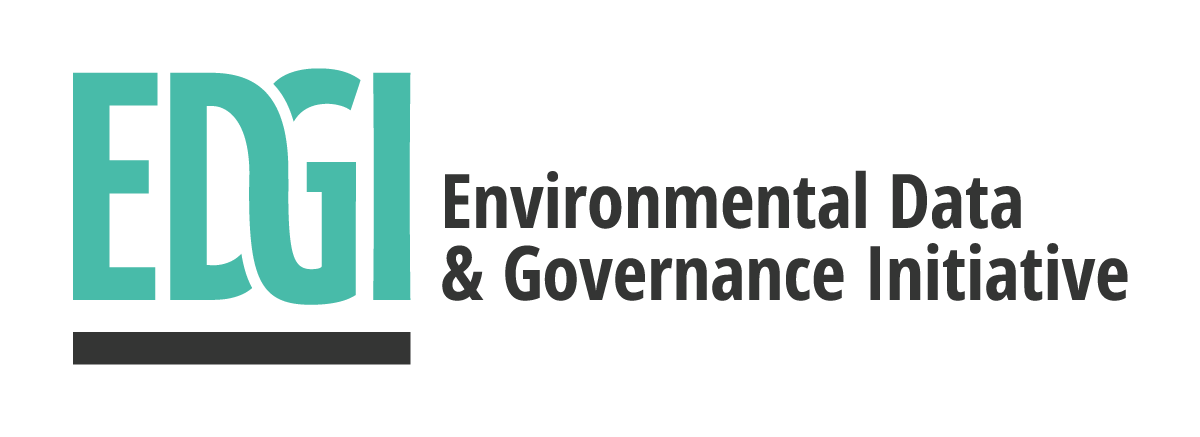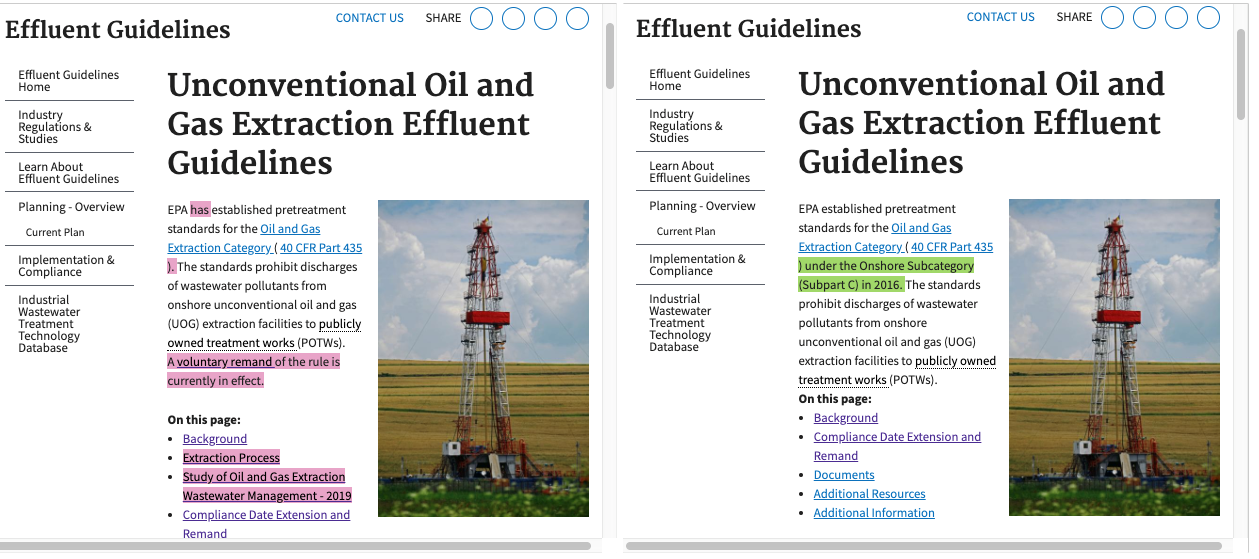By: Gretchen Gehrke, Marcy Beck, Alejandro Paz, Sara Wylie, Kelly Wilkins, and Kelsey Breseman
EDGI’s Website Monitoring team has just published the first of a new kind of report: from the perspective of web resource governance, we assess observed changes to EPA’s Unconventional Oil and Gas Extraction Effluent Guidelines webpage, the primary resource for the public to learn about hydraulic fracturing wastewater discharge. This report focuses on changes that occurred during a period of regulatory proceedings this summer, and addresses information development and management.
In EDGI, we monitor thousands of federal agency webpages about climate, energy, and the environment. One of the primary reasons we document changes to federal websites is to foster a spirit of and facilitate actions toward more transparent and information-positive web resource governance by our federal agencies. Until now, our reports have focused exclusively on detailing changes we observed on federal websites. However, in order to inspire better federal web resource governance, we also need to present our analyses of current practices and provide both conceptual and concrete recommendations for improvements. Changes to EPA’s Unconventional Oil and Gas Extraction Effluent Guidelines webpage during a period of regulatory proceedings this summer–such as the removal of background information on hydraulic fracturing wastewater and the removal of a section about a current EPA study that could put the current wastewater discharge prohibition at risk–provided a bounded example for our review, documentation, analysis, and recommendations addressing better management of that informational page.
Why web resource governance matters
Federal agency websites are regarded as authoritative sources of information. The public turns to these sites in large numbers. For example, according to Alexa.com analytics, EPA’s homepage is the 1,610th most visited website in the US in Fall 2019, and people find EPA’s website by searching for a very broad range of terms and topics. For many topics, web visitors can find basic educational material and summaries of relevant rules and regulations. Information about regulations on agency websites is generally much more discoverable by topic and is more approachable than information published elsewhere by the federal government, such as the Federal Register website.
Strict management and maintenance of agency webpages that are labeled as informational resources about regulations are very important, as these are primary avenues for the public to learn about regulations that affect them and their environment. Agencies have the opportunity to provide information about the purpose, scope, and specific evolution of regulations. By providing sufficient context and a transparent regulatory process, websites, and especially regulatory-focused webpages, can become an avenue of trust-building between agencies and the public. The opposite is also true: with insufficient context, regulations may seem obscure or inappropriate, and agency websites may become an avenue for the public to become skeptical or disgruntled. For example, there was public outrage at EPA’s removal of its Climate Change website on the eve of the People’s Climate March in 2017.
Example case: Unconventional Oil and Gas Extraction Effluent Guidelines
EPA’s Unconventional Oil and Gas Extraction Effluent Guidelines webpage is the single webpage identified for readers to find further information about the Effluent Limitations Guidelines and Standards for the Oil and Gas Extraction Point Source Category rule, and does provide some important context about the rule. However, recent changes to the webpage have detracted from its comprehensibility. This rule, prohibiting the discharge of oil and gas extraction wastewater to surface waters through publicly owned treatment works (POTWs), was initially promulgated in 2016. After an extensive review due to a 2016 appeal by industry, the rule was upheld by EPA in July 2019. Within days of this decision, EPA removed considerable contextual information (compare July 1 versus July 2, 2019) from its Unconventional Oil and Gas Extraction Effluent Guidelines page including:
- a section of the webpage that explained unconventional oil and gas (UOG) extraction and wastewater generation processes, which would help the reader understand why and how the new rule is applicable to UOG wastewater;
- a short description of and link to the ongoing Study of Oil and Gas Extraction Wastewater Management, which is exploring possible means by which regulations could allow for broader discharge of UOG wastewater to surface waters, and could impact the applicability of this rule in the future;
- and text explaining the process EPA had implemented to come to its conclusion that the original 2016 final rule would stand.
Each of these pieces of information are important for a reader to understand the purpose and status of this important regulation.
First order recommendations
In order to make webpages such as the Unconventional Oil and Gas Extraction Effluent Guidelines page more accessible, transparent, and informative, we recommend that federal agencies adopt the following standards for content and records management of regulatory information:
- retain historical information that had appeared on a webpage to demonstrate the evolution of a rule rather than replacing it as regulatory proceeding statuses change.
- provide access to a record of changes made to each webpage, so even if they don’t retain information in the text of the page itself, a web visitor could find historical information.
- include links to pages containing related information and provide summaries of their content.
- employ ladders of information with increasing detail in their website structure so web visitors can easily navigate from baseline summaries to detailed scientific information, serving both the general public and audiences more engaged with specific subject matters.
Read the full report here and keep an eye out for more web governance reports and recommendations from our team in EDGI. Please also share your thoughts about this report or web governance issues by emailing edgi.websitemonitoring@protonmail.com. We’ll synthesize feedback received and will post it in an upcoming blog. Thank you!

